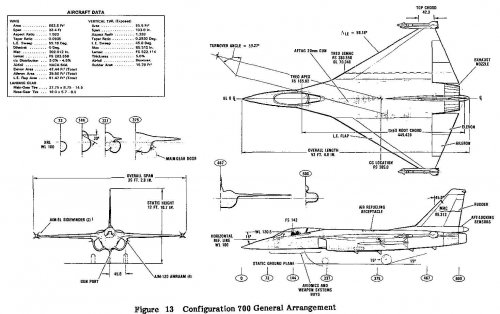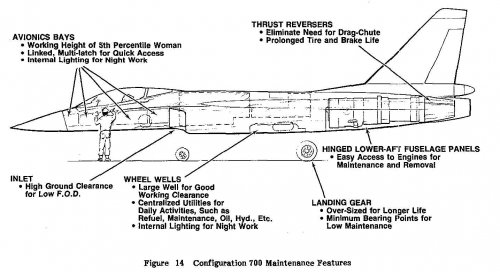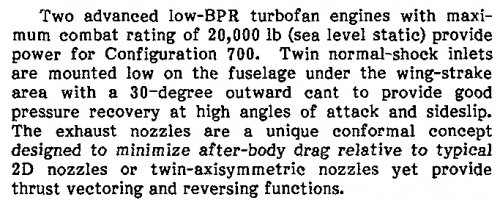You are using an out of date browser. It may not display this or other websites correctly.
You should upgrade or use an alternative browser.
You should upgrade or use an alternative browser.
General Dynamics ATS, pre-ATF and ATF designs
- Thread starter flateric
- Start date
- Joined
- 3 January 2006
- Messages
- 1,223
- Reaction score
- 940
flateric said:General Dynamics 1986 Supportable Fighter study (Configuration 700)
I have seen a drawing of a proposed F-16 derivative with a similar trapezoidal wing planform - although it dates from 5 years later.
Flateric, is this the original size of the scan or did you downsize it for this forum? It would be interesting to see the data table, and few other details.
- Joined
- 3 January 2006
- Messages
- 1,223
- Reaction score
- 940
Flateric, do you have any weight numbers for this design? This thing is the size of a Rafale or Hornet, but it has the wing area of a F-15.
I would also have to wonder about the engine choice. Judging by the date of the project and the drawings, I would guess that the PW-1120 or the F-404 might have been baseline powerplants.
I would also have to wonder about the engine choice. Judging by the date of the project and the drawings, I would guess that the PW-1120 or the F-404 might have been baseline powerplants.
- Joined
- 27 December 2005
- Messages
- 17,743
- Reaction score
- 26,327
- Joined
- 6 August 2007
- Messages
- 3,888
- Reaction score
- 5,911
overscan said:Dating from the late 1970s, in the earliest stages of what became ATF when the strike role was dominant. We've seen other ATS designs from e.g. Northrop but I don't recall seeing these posted.
Source:
Albert C. Piccirillo, Origins of the F-22 Raptor
I see the GD "Model 100" was alive and well that far back.
- Joined
- 2 August 2006
- Messages
- 3,255
- Reaction score
- 1,527
I believe I've seen pics of the bottom design, a model of it, in an old issue of Combat Aircraft or Combat Arms, I think I have it somewhere. I'll see if I can dig it up, later in the year, when I've finished moving.
- Joined
- 27 December 2005
- Messages
- 17,743
- Reaction score
- 26,327
Merged with ATS topic.
XP67_Moonbat
ACCESS: Top Secret
- Joined
- 16 January 2008
- Messages
- 2,271
- Reaction score
- 541
Is that Sneaky Pete?
- Joined
- 6 August 2007
- Messages
- 3,888
- Reaction score
- 5,911
XP67_Moonbat said:Is that Sneaky Pete?
It certainly is.
- Joined
- 22 January 2006
- Messages
- 4,212
- Reaction score
- 2,007
Albert C. Piccirillo, Origins of the F-22 Raptor
Do you recommend this book? I have no clear idea about the contents ???
- Joined
- 6 August 2007
- Messages
- 3,888
- Reaction score
- 5,911
pometablava said:Albert C. Piccirillo, Origins of the F-22 Raptor
Do you recommend this book? I have no clear idea about the contents ???
You can preview some of it on Google Books:
Advanced Tactical Fighter to F-22 Raptor
books.google.com
- Joined
- 27 December 2005
- Messages
- 17,743
- Reaction score
- 26,327
Its pretty authoritative as a history of the ATF program, which you would expect given the authors. Its not got many pictures and is a bit "dry" in tone, so its not a thrilling read.
This book traces the history of the ATF program and the evolution of the ATF requirements from the beginning of the program through the start of the engineering and manufacturing development.
Model of General Dynamics Advanced Tactical Fighter (ATF) design submission.
According to F-22 Raptor (Enthusiast Color Series) by Bill Sweetman, MBI Publishing Company, 1998:
According to F-22 Raptor (Enthusiast Color Series) by Bill Sweetman, MBI Publishing Company, 1998:
Runner up to Lockheed and Northrop was General Dynamics, with a tailless delta design that reflected the success of the F-16XL. The dramatically serrated trailing edge has the same alignments as the leading edge of the wing. General Dynamics proposed to put two radar arrays in the leading-edge root extensions, above the inlets, and an infrared sensor in the nose. The single vertical tail, however, detracted from its all aspect stealth.
Attachments
XP67_Moonbat
ACCESS: Top Secret
- Joined
- 16 January 2008
- Messages
- 2,271
- Reaction score
- 541
In my LEGALLY PURCHASED copy of "Warplanes Of The Future", it's stated that one of the ATF designs GD looked at was at a classification so high that USAF officials were not allowed to see it.
As a substitute, they showed drawings of a notional plane nicknamed "The Marshmallow".
I'll go out on a limb and assume that super-secret design was the Model 100 ("Sneaky Pete")? But has anybody ever seen the design for "Marshmallow"?
As a substitute, they showed drawings of a notional plane nicknamed "The Marshmallow".
I'll go out on a limb and assume that super-secret design was the Model 100 ("Sneaky Pete")? But has anybody ever seen the design for "Marshmallow"?
Matej
Multiuniversal creator
XP67_Moonbat said:And has anybody ever seen the design for "Marshmallow"?
yes
One of two early General Dynamics candidates for ATF was a descendent of Sneaky Pete. The company, however, was not allowed to show USAF officials actual drawings of this design because of its classification. The company substituted surrogate drawings of a notional fighter that USAF officials soon dubbed the marshmallow. The real design was the starting point for all-wing studies explored in the next phase of the program.
Attachments
XP67_Moonbat
ACCESS: Top Secret
- Joined
- 16 January 2008
- Messages
- 2,271
- Reaction score
- 541
Aha! Thank you, sir.
- Joined
- 6 August 2007
- Messages
- 3,888
- Reaction score
- 5,911
XP67_Moonbat said:In my LEGALLY PURCHASED copy of "Warplanes Of The Future", it's stated that one of the ATF designs GD looked at was at a classification so high that USAF officials were not allowed to see it.
As a substitute, they showed drawings of a notional plane nicknamed "The Marshmallow".
I'll go out on a limb and assume that super-secret design was the Model 100 ("Sneaky Pete")? But has anybody ever seen the design for "Marshmallow"?
Not 100% true. ASD had run the Sneaky Pete effort with GD and it was considered sensitive. A hypothetical, representitive silhouette was used as a stand-in in some places to prevent revealing the shape. ASD had extensively studied and tested the shape and thus used it as a yardstick for other things. Sneaky Pete and the Marshmallow though didn't have anything in common.
I've been working on a more detailed history of Sneaky Pete but my occupation has been getting in the way. As far as I have been able to tell, Sneaky Pete was not revolutionary at all.
- Joined
- 26 May 2006
- Messages
- 34,869
- Reaction score
- 15,733
Attachments
Last edited by a moderator:
XP67_Moonbat
ACCESS: Top Secret
- Joined
- 16 January 2008
- Messages
- 2,271
- Reaction score
- 541
Didnt they have a B-32 style tail on that design at one point?
donnage99
ACCESS: Top Secret
- Joined
- 16 June 2008
- Messages
- 1,355
- Reaction score
- 861
from the new Code One magazine website:

The General Dynamics design for the dem/val phase evolved from a variety of inputs. During the previous program phase, the company had focused on three separate families of aircraft: conventional, all-wing, and semi-tailless (denoted in the configuration studies by C, W, and T, respectively). The conventional family derived from the Model 21 designs of the previous studies. The all-wing family strove to carry Sneaky Pete's minimum observables into the supersonic regime. The semi-tailless family, which had a single vertical tail, fell in between these two extremes. After a series of internal design competitions and trades, the company went with the semi-tailless approach.

<title> | Code One Magazine</title>
www.codeonemagazine.com
Attachments
- Joined
- 2 August 2006
- Messages
- 3,255
- Reaction score
- 1,527
I've seen conflicting reports here at Secret Projects about what "Sneaky Pete" was/is. I notice that they are officially regarding the flying design as "Sneaky Pete" in those images, so is it official now, or was there a competing design from another manufacturer?
- Joined
- 6 August 2007
- Messages
- 3,888
- Reaction score
- 5,911
Sundog said:I've seen conflicting reports here at Secret Projects about what "Sneaky Pete" was/is. I notice that they are officially regarding the flying design as "Sneaky Pete" in those images, so is it official now, or was there a competing design from another manufacturer?
Sneaky Pete was the nickname of the GD Model 100. During the period that USAF Aeronautical Systems Division was managing the project (likely as a demonstrator, but not confirmed) it was under the name HAVE KEY. Sneaky Pete was an active project at GD from approximately 1976-1984. There was no direct connection to HAVE BLUE, etc. - GD was running it's own VLO effort for a long time with Model 100 as the output, and ASD showed interest in it.
There was no competition for Sneaky Pete, it started out life as a contractor effort and later gained support from ASD.
- Joined
- 2 August 2006
- Messages
- 3,255
- Reaction score
- 1,527
quellish said:Sundog said:I've seen conflicting reports here at Secret Projects about what "Sneaky Pete" was/is. I notice that they are officially regarding the flying design as "Sneaky Pete" in those images, so is it official now, or was there a competing design from another manufacturer?
Sneaky Pete was the nickname of the GD Model 100. During the period that USAF Aeronautical Systems Division was managing the project (likely as a demonstrator, but not confirmed) it was under the name HAVE KEY. Sneaky Pete was an active project at GD from approximately 1976-1984. There was no direct connection to HAVE BLUE, etc. - GD was running it's own VLO effort for a long time with Model 100 as the output, and ASD showed interest in it.
There was no competition for Sneaky Pete, it started out life as a contractor effort and later gained support from ASD.
OK, that's what I thought. I went back and did a search and realized that this isn't to be confused with "Sneeky Pete," which is where some of my confusion came from.
BTW, do we know if Sneaky Pete was actually built and flown? I've read reports as such, but I'm just wondering if it has ever been verified and I've also heard that Sneaky Pete and the Model 100 were two different aircraft.
- Joined
- 25 June 2009
- Messages
- 14,749
- Reaction score
- 6,112
Well, from what I gather, the General Dynamics Model 100 (or VX-11) was called the "Cold Pigeon", and was distinct from "Sneaky Pete". The latter is the one shown in camouflage in the diagram above; the Model 100 is attached here for comparison. Two easy ways to tell them apart: Pete's trailing edge is a straight line; the Model 100 shows two separate exhausts at the rear. It would seem that the Model 100 was meant as a sub-scale model, while Sneaky Pete, with its proper cockpit, could have been the manned article, if ever there was such a thing...
Attachments
- Joined
- 27 December 2005
- Messages
- 17,743
- Reaction score
- 26,327
Cold Pigeon was the c.1976 early concept and 1/4 scale model (probably the model depicted above) which had evolved by August 1977 into "Sneaky Pete". AFAIK Model 100 applied to the whole program.
- Joined
- 2 August 2006
- Messages
- 3,255
- Reaction score
- 1,527
overscan said:AFAIK Model 100 applied to the whole program.
Thanks, that makes sense to me.
Colonial-Marine
UAVs are now friend, drones are the real enemy.
- Joined
- 5 October 2009
- Messages
- 1,468
- Reaction score
- 1,323
donnage99 said:Ironic that while General Dynamics tried to get their design to able to fly and had to compromised themselves with a vertical tail that contributed to their downfall, Lockheed won with a unflyable design.
Do you mean "unflyable" as in naturally unstable or as in it would have been impossible for Lockheed to actually make their chosen design fly?
- Joined
- 24 January 2006
- Messages
- 1,322
- Reaction score
- 468
Colonial-Marine said:Do you mean "unflyable" as in naturally unstable or as in it would have been impossible for Lockheed to actually make their chosen design fly?
It was literally unflyable. The design had way too much pitch instability generated by the gigantic LERX that extended to the nose. Lockheed noticed that there was no way to counter it unless the tail surfaces pretty much grew past the size of the wings. Obviously this was not going to work, so in 87 or 88 they threw it out and came up with what turned into the YF-22. Which is funny, because of Lockheed's various ATF designs that led to the unflyable submission, one of them was pretty close to the eventual YF-22.
- Joined
- 6 August 2007
- Messages
- 3,888
- Reaction score
- 5,911
Sundog said:BTW, do we know if Sneaky Pete was actually built and flown? I've read reports as such, but I'm just wondering if it has ever been verified and I've also heard that Sneaky Pete and the Model 100 were two different aircraft.
Because it has implications for the A-12 court cases, "hard" information on Sneaky Pete is going to take a while. GD was not able to use experience gained from SP/Model 100 on ATA/A-12 because of classification walls and turf battles, and that contributed to the A-12's escalating costs and delays. If details of the program came out it could really complicate the ongoing litigation, and open up a whole new can of worms. It's likely that GD's original cost estimates were based on knowledge gained from that program (SP).
Now, looking at SP with what we know today, the shape itself does not seem nearly as LO as HAVE BLUE or TACIT BLUE, so you have to wonder if there was more to it. Based on the documents in this thread (and many others), the feeling you may get is that GD felt that their VLO "special sauce" was entirely in that design/configuration rather than a process like those developed by Lockheed or Northrop that could be applied to different configurations and missions. GD took the subsonic SP and tried to hammer it into the shape of a supersonic fighter.
donnage99
ACCESS: Top Secret
- Joined
- 16 June 2008
- Messages
- 1,355
- Reaction score
- 861
Very insightful take on it; I never thought of it that way. However, I would have to disagree on the suggestion that the cost estimate of A-12 had been based on knowledge gained from SP/100 which they couldn't used. The cost estimate would have to come from the team that was gonna build A-12, which did not have access to the experience and knowledge of the SP/100's team. Therefore, they couldn't possibly estimate the cost based on experience gained from SP/100.quellish said:Based on the documents in this thread (and many others), the feeling you may get is that GD felt that their VLO "special sauce" was entirely in that design/configuration rather than a process like those developed by Lockheed or Northrop that could be applied to different configurations and missions. GD took the subsonic SP and tried to hammer it into the shape of a supersonic fighter.
- Joined
- 27 December 2005
- Messages
- 17,743
- Reaction score
- 26,327
The straight trailing edge on the A-12 and Sneaky Pete complicates RCS reduction as it will give a spike directly forward and directly aft, not ideal locations. Presumably they were relying on deep RAM in leading and trailing edges to counteract that (though this isn't really evident in the inboard profiles) but the blunt convex leading edge wing would give more radar return compared to the scalloped profile of the B-2, YF-23 etc edges.
The A-12 detail drawings show no alignment of panel edges with the wing geometry, and the overall "stealth" technology appears no different from Dan Raymer's Delta Spanloader for Rockwell. The landing gear doors, weapons bay doors etc would create additional spikes front, 90 deg abeam each side, and to the rear, for 7 major RCS spikes, not to mention the canopy.
The A-12 detail drawings show no alignment of panel edges with the wing geometry, and the overall "stealth" technology appears no different from Dan Raymer's Delta Spanloader for Rockwell. The landing gear doors, weapons bay doors etc would create additional spikes front, 90 deg abeam each side, and to the rear, for 7 major RCS spikes, not to mention the canopy.
Similar threads
-
Delta wing F-16s: SCAMP, F-16XL, Falcon 21 and more
- Started by flateric
- Replies: 218
-
Convair / General Dynamics Advanced Tactical Fighter (1965)
- Started by overscan (PaulMM)
- Replies: 15
-
McDonnell-Douglas ATS, pre-ATF and ATF studies
- Started by flateric
- Replies: 174
-
-
Boeing Fighter Studies, 1970s to ATF
- Started by flateric
- Replies: 134











